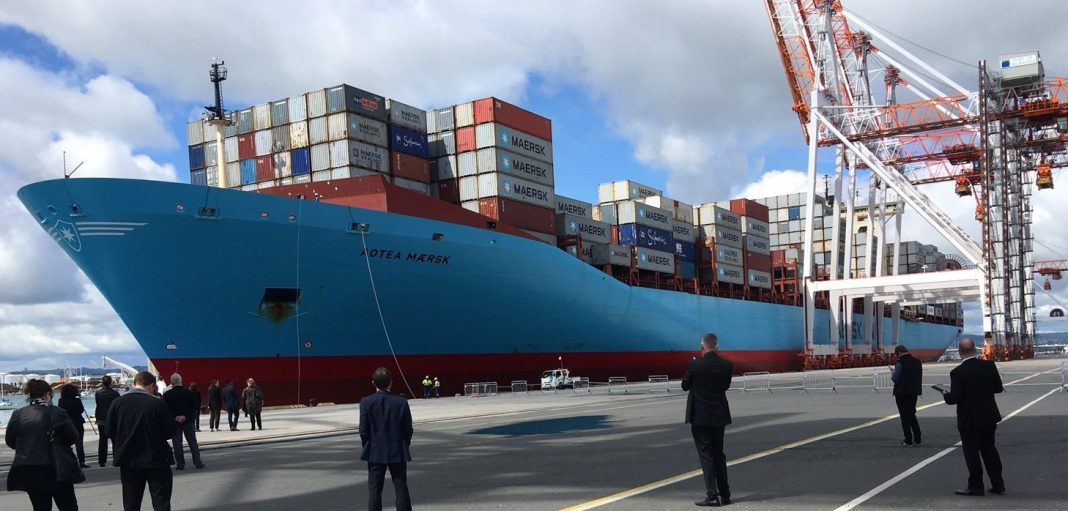Port of Tauranga (POT), New Zealand’s largest port, has reported record cargo volumes and increased profits for the year to 30 June 2019.
Group Net Profit After Tax passed the $100 million milestone for the first time, increasing 6.7 percent on last year’s profit of $94.3 million to reach $100.6 million.
The port has consolidated its position as New Zealand’s international hub port, with transhipment increasing 11.2 percent.
Port chair David Pilkington said Transhipment (where containers are transferred from one service to another), had been growing significantly since 2016, when it completed its $350 million capacity expansion programme to accommodate bigger container ships.
Transhipment now makes up 32.1 percent of the containers handled at Tauranga. New Zealand shippers can access fast, big ship services that only call in Tauranga by utilising the sea links between Tauranga and Timaru, Napier, Nelson or Wellington.
Long-term agreements
Pilkington said the port’s long-term agreements with key customers gave it the assurance to plan ahead for increases in cargo growth.
The port recently renewed its 10-year operating agreement with major customer Oji Fibre Solutions.
“Having the necessary infrastructure is one thing, but it is also vital to have the relationships to ensure we have the freight volume to attract the big ship services,” said Pilkington.
“We have long-term agreements in place with key cargo owners such as Oji Fibre Solutions, Fonterra’s shipping supplier Kotahi Logistics and Zespri International.”
Chief executive Mark Cairns said the increased number of containers transferred by rail to and from Tauranga’s inland freight hub, MetroPort Auckland, meant that MetroPort Auckland currently stands alone as the country’s fourth largest container terminal by volume.
The recently announced partnership with Tainui Group Holdings (see our cover story) would help Waikato-based importers and exporters unlock the significant efficiencies to be gained by being directly linked by rail to the big ship services calling at Tauranga, said Cairns.
Port of Tauranga has also expanded its MetroPort Christchurch inland freight hub by constructing a large warehouse that is being leased by associate company Coda Group to handle Westland Milk’s dairy exports.
Cairns said the development of the group’s network of ports, inland freight hubs and logistics services, ensured importers and exporters in key cargo-producing areas throughout the country could access the efficiencies offered by bigger ships.
“The availability of rail and coastal shipping to consolidate cargo at Port of Tauranga, and the efficiency of the big ship services, means we can also offer a lower carbon supply chain to our customers,” he said.
Sustainability
Reiterating the port’s commitment to sustainability, Cairns said it favoured rail transport over road because of the lower emissions.
“We are working with our rail partners KiwiRail to reduce train-related emissions through efficiency and technology. We are also working with our partners Pacifica Shipping to promote greater use of coastal shipping where feasible,” he said.
The availability of rail and coastal shipping to consolidate cargo at the port, and the efficiency of the big ship services, means Port of Tauranga was the obvious choice for customers seeking the lowest carbon supply chain, he said.
Big ships of 7500 to 9500 TEUs have a carbon footprint more than 31 percent lower than the previous average size vessels calling in New Zealand.
Cargo trends
Exports increased 11.2 percent to 17.1 million tonnes and imports increased 8.4 percent to 9.8 million tonnes for the 12 month period. Log exports increased 12.5 percent to 7.1 million tonnes.
However, as Cairns noted to Bay of Plenty Business News, the drop in demand from China and in log prices is expected to impact future earnings.
“We expect some impact on volumes in the coming months.”
Looking to the 2020 financial year, Cairns said log volumes were expected to fluctuate in the coming months following the recent drop in international prices.
Dairy product exports remained steady at just over 2.3 million tonnes, while imports of dairy herd food supplements and fertiliser decreased by 11.8 percent and 9.2 percent respectively. Kiwifruit exports increased 15.2 percent during the period.
Other primary produce sectors also performed strongly, with frozen meat exports increasing 18.8 percent in volume and apple exports increasing 54.3 percent. Cement imports decreased 17.1 percent in volume and steel exports decreased 7.7 percent.
Ship visits decreased 3.9 percent to 1678 for the year, but the average size of vessels continues to increase.
Port of Tauranga is now planning for the next stage of growth and in response to customer demand, intends to add another container vessel berth by extending up to 385 metres to the south of the existing Sulphur Point wharves.
A ninth container crane will be delivered in January 2020.
Port of Tauranga will provide an update on the first quarter’s trade, and earnings guidance for the full year, at the Annual Shareholders’ Meeting on 25 October 2019.
Highlights – 12 months to June 2019
• Group Net Profit After Tax increases 6.7% to $100.6 million.
• Annual container throughput increases 4.3% to more than 1.2 million TEUs.
• Transhipment increases 11.2%, making up 32% of all container traffic.
• Log export volumes increase 12.5% to 7.1 million tonnes.
• Exports increase 11.2% to 17.1 million tonnes.
• Imports increase 8.4% to 9.8 million tonnes.
• Annual revenue increases 10.4% to $313.3 million.
• Final dividend of 7.3 cents per share bringing the full year dividend to 13.3 cents per share, a 4.7% increase on the previous year.
• A special dividend of 5.0 cents per share will also be paid, and the capital repayment programme will be extended for another four years.


















